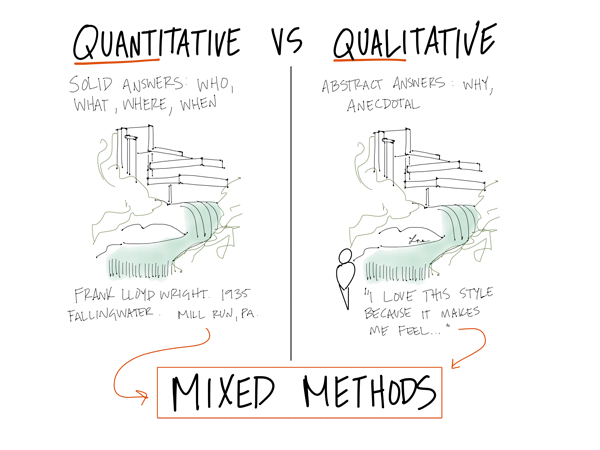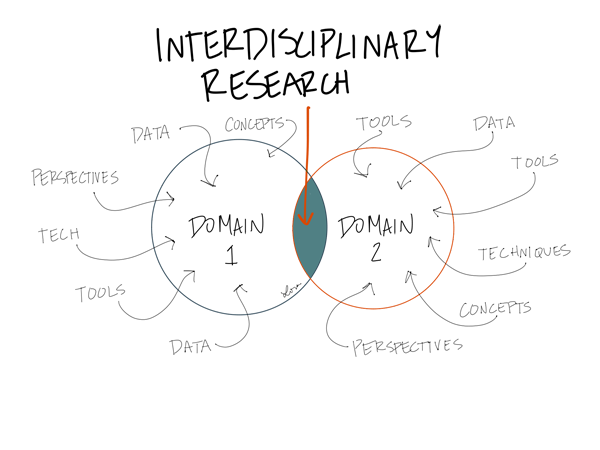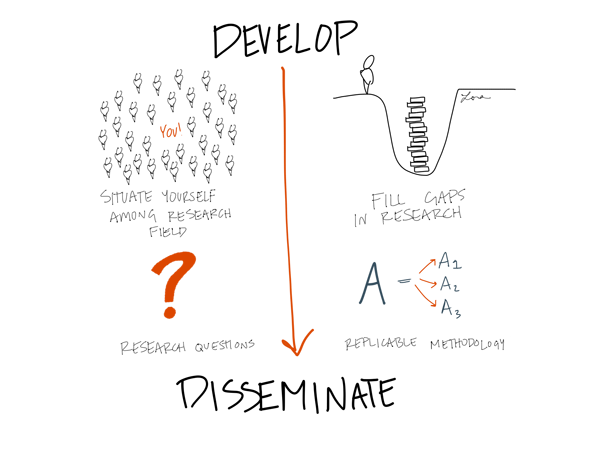The Association of Collegiate Schools of Architecture (ACSA) and TECHNOLOGY | ARCHITECTURE + DESIGN (TAD) journal teamed up to create Exploring/Defining the Research Landscape within the Discipline of Architecture, an introductory-level video to aid understanding of the importance of research to architectural practice.
View the webinar | View the entire webinar series
To whet your appetite and synopsize six main concepts presented in Webinar #1, L2 Design LLC, created the sketches below. Please take a moment to rate this approach to information presentation, using the stars at the bottom of the page.
1. What is architectural research?

2. How do you find your place on the spectrum of research and within your community of scholars?

3. What is quantitative, qualitative, and mixed methods research?

4. What is interdisciplinary research?

5. How do you develop a focused research question and methodology?

6. How do you assemble a successful team?

Note:: The full webinar expands upon the concepts of architectural research and provides more detailed explanations, such as the following points. Quantitative research is about measured results. Qualitative research is about identifying qualities and understanding underlying reasons and motivations. Developing a focused research question and methodology includes identifying the need / what can be improved as well as replicable methodology and the ability to transfer to other conditions / projects.
About the Contributors
TAD
TECHNOLOGY | ARCHITECTURE + DESIGN (TAD) is a peer-¬reviewed international journal dedicated to the advancement of scholarship in the field of building technology and its translation, integration, and impact on architecture and design. Published articles feature primary research in emerging materials, construction techniques, design integration, structures, building systems, energy, environmental design, information technology, digital fabrication, sustainability and resiliency, project delivery, the history and theory of technology, and building technology education. Intended for researchers, educators, and practitioners, the journal advances and transforms the current discourse on building-¬based technologies with the goal of expanding, reimagining and challenging its role for architecture and design.
TAD is a journal of the Association of Collegiate Schools of Architecture (ACSA) and is also made possible through additional support from the American Institute of Architects (AIA) and the Building Technology Educators Society (BTES). TAD is published by Taylor & Francis and select issue content can be viewed online.
ACSA
The mission of the Association of Collegiate Schools of Architecture (ACSA) is to lead architectural education and research. ACSA is a 501(c)(3) nonprofit association of over 200 member schools in several categories. Through these schools, over 5,000 architecture faculty are represented. In addition, over 300 supporting members composed of architecture firms, product associations and individuals add to the breadth of interest and support of ACSA goals. ACSA, unique in its representative role for schools of architecture, provides a forum for ideas on the leading edge of architectural thought. The association maintains a variety of activities that influence, communicate, and record important issues. Such endeavors include scholarly meetings, workshops, publications, awards and competition programs, support for architectural research, policy development, and liaison with allied organizations.
L2 Design, LLC (Creator of Sketches)
Lora Teagarden, AIA, is a 2017 Young Architects Award recipient and is the author/creator of the AREsketches™ volumes which are visual study aides for the ARE exams. Lora is the 2019 Young Architects Forum Chair and has an active social media presence.
AIA
Founded in 1857, AIA consistently works to create more valuable, healthy, secure, and sustainable buildings, neighborhoods, and communities. Through more than 200 international, state and local chapters, AIA advocates for public policies that promote economic vitality and public wellbeing. AIA provides members with tools and resources to assist them in their careers and business as well as engaging civic and government leaders and the public to find solutions to pressing issues facing our communities, institutions, nation, and world.
NIBS
The National Institute of Building Sciences successfully brings together representatives of government, the professions, industry, labor and consumer interests, and regulatory agencies to identify and resolve problems and potential problems that hamper the construction of safe, affordable structures for housing, commerce and industry throughout the United States. Established by the U.S. Congress in 1974, the Institute is a non-profit, non-governmental organization.

